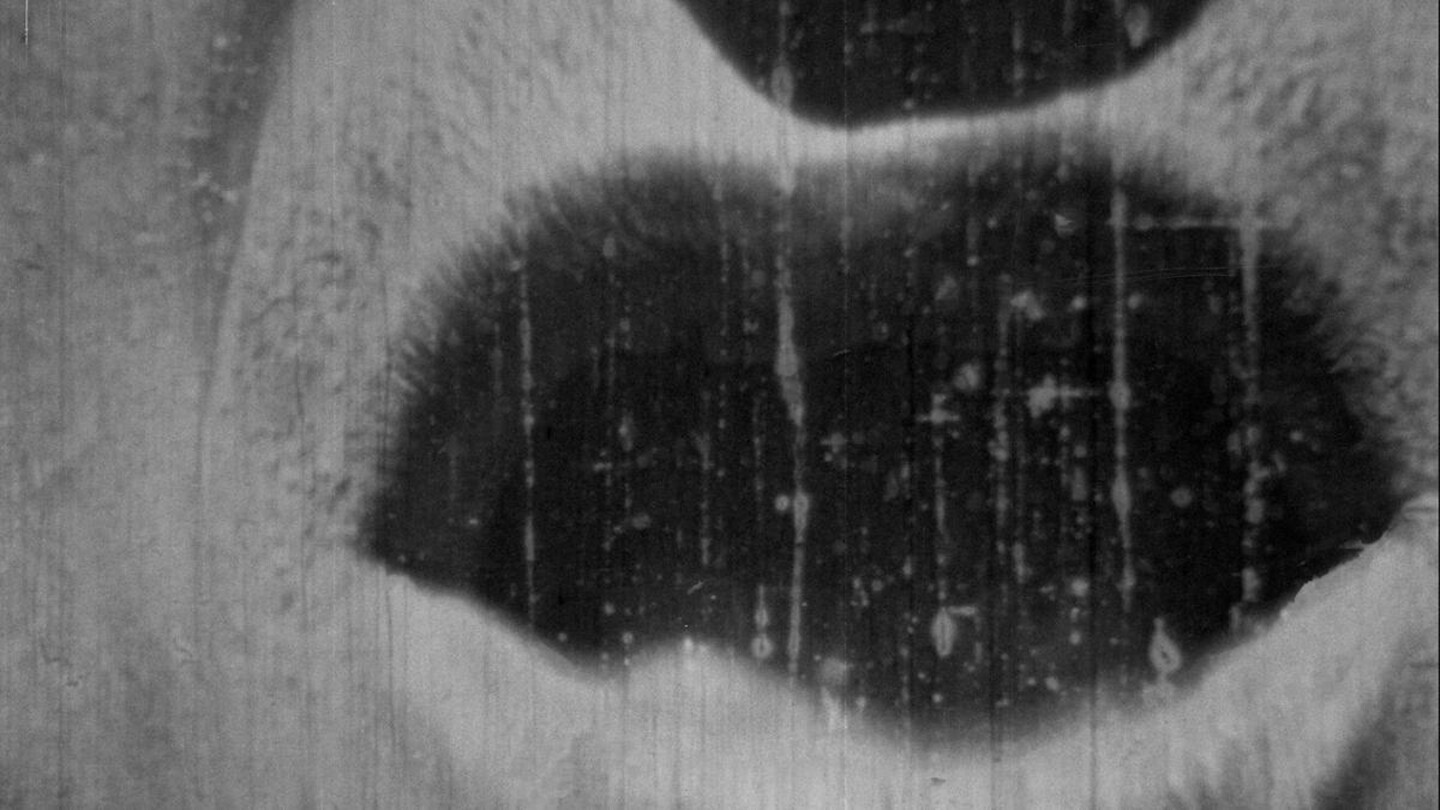The great trouble in human life is that looking and eating are two different operations.
—Simone Weil, Forms of the Implicit Love of God, 1951
1. Eater and Eaten
“In some aspects,” wrote Gaston Bachelard in 1938, “reality is initially a food.”1 Bachelard wrote this in the context of his reflections on some of the more colorful stories about digestion that proliferated in the prescientific European mind, particularly during the long transition from alchemy to chemistry. Eighteenth-century alchemists, he explained, perceived God as the greatest alchemist of all. The human stomach was said to be one of God’s greatest inventions, an oven for his earthly chemistry lab. The human ability to understand and manipulate individual chemical elements would always pale in comparison to the alchemy of digestion, which was designed with celestial complexity.2 In this model, digestion takes on expansive metaphysical dimensions that appear far removed from how we might conceive of digestion today. But digestion theories are fundamental representations of how one conceives of the threshold where the body meets the world. As such, any understanding of how the body digests is always in some way metaphysical, a product of models for how the body is more broadly situated in the world within a given cosmology.
Digestion has a well-charted history in Western science. Throughout the second half of the nineteenth century, the renowned French physiologist Claude Bernard sought to produce an experimental framework that would prove objectively what happened when one organism ate another. He was eager to distinguish himself from many of his contemporaries in chemistry and physiology, whose mechanistic models of life likened animal bodies to machines, which received inputs of matter that they burned to produce energy. Bernard outlined a much more dynamic model of the body’s material constitution, one that showed that the parts not only processed inputs, but were themselves constantly changing. The body doesn’t simply break down the stuff it takes in, it builds new things out of them.
In sociologist Hannah Landecker’s ongoing mapping of the history of the modern concept of metabolism as it emerged from industrial modernity to today, she shows how influential Bernard’s work was not only for the science of nutrition and physiology, but for far-reaching notions of autonomy and freedom. For the living organism to be “free,” according to Bernard, it had to possess mechanisms that allowed it a greater degree of agency than, say, a plant. Organisms clearly require constant inputs from their environment, but Bernard’s work showed that animals have highly organized internal processes that regulate these inputs, turning them into the stuff of their own bodies. This was the milieu intérieur, the concept for which Bernard is perhaps best known. His idea that the animal had, in Landecker’s words, the “ability to turn the environment into itself through nutrition,” was conceived by Bernard as the very condition for the animal’s freedom.3
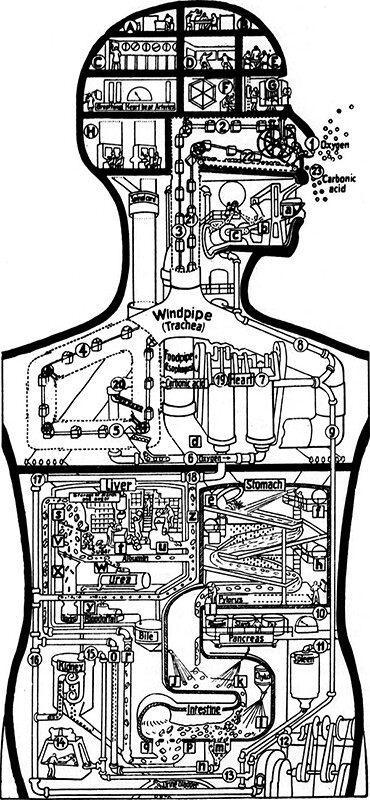

Image from Arthur and Fritz Kahn Collection 1889–1932, pg. 118.
Crucial to this model of nutrition is the perceived certainty that once food enters the internal environment, it loses the properties that defined it in the external environment. Bernard noted that a dog eating mutton, for example, doesn’t store the mutton’s fat, but rather makes its own fat by breaking down the mutton fat cells and turning them into dog fat. The conversion of the world into the self in this model is the basis upon which the eating organism increases its freedom to move through the world. Landecker refers to this idea as the logic of “eater and eaten,” where animals convert those below them in the food chain into themselves in a biologically ordained hierarchy. This logic of total conversion has been so central to an understanding of being in industrial and postindustrial modernity, both scientific and metaphysical, that its origins and implications are scarcely questioned. That this logic was a historical construction only became apparent when contrasted with empirical evidence strong enough to destabilize it.
Moving between historical models and the edge of contemporary science, Landecker brilliantly charts this destabilization. She describes an article published in 2011 by a group of molecular biologists in China who discovered genetic material from rice in a mouse’s liver.4 This foreign genetic material participated in the regulation of the mouse’s own genes. Everything that the nineteenth- and twentieth-century logic of conversion in the food chain taught us would deny this possibility. Gene regulation was meant to belong to that part of the self that could not be affected by nutrition, i.e., the dissolution of other organisms’ identities into the self. Yet here, an identifiable piece of a foreign organism changed the host’s own identity, long after the foreign organism should have been broken down into an identity-less mass.
New models of life that focus on the interrelations between organisms have emerged in recent decades, encapsulated, for example, in evolutionary biologist Lynn Margulis’s concept of the “holobiont,” which proposes that organisms evolve symbiotically together with their endocellular and extracellular microbiome.5 As science and culture adapt to such radically altered perspectives on life conceived as distributed among incalculable organisms, the historical specificity of the logic of the total conversion of the eaten into the eater’s body is obvious. From this vantage point, it is hard to ignore that the logic of food-chain conversion is also a model of empire, a model in which the eater absorbs all environmental differences into its own homogenizing self.
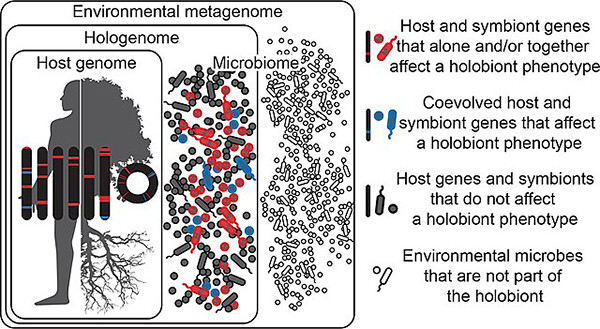

The holobiont phenotype. License: CC BY-SA 4.0.
“Life is death,” writes Landecker of Bernard’s vision of conversion. “This only appears paradoxical: it is not problematic to be composed of dead others, because they have ceased to be themselves in any meaningful way: they ‘disappear as a definite chemical material’ and become the reserves, always identical.”6 In this way a European model of autonomous being emerged, nested in the mechanical objectivity of science and disseminated as common sense, where eating the world and dissolving its defining features into oneself is the fundamental material condition for freedom. The model of total conversion turned digestion—the living organism’s perpetual renegotiation with its environment—into consumption, an untethered force that belongs to no specific being or body.
2. The Perpetual Big Swallow
My interest in the history of metabolism started from a practice that might seem far from such matters: moving images. As an artist filmmaker, I have always been perplexed by the ways that moving images are simultaneously continuous with and separate from the open-ended worlds they record and the profilmic worlds they present to the spectator. Moving images act on and reconfigure the boundary between the body and the world. The history of moving images offers glimpses towards how those boundaries have perpetually changed. Metabolism describes the material exchange that takes place between organism and environment. As I learned more about the historicity of the concept of metabolism, how metabolism itself is constantly changing, I began to conceive of metabolism not simply as some neutral underlying condition of life—as most common definitions would have it—but as a changing model of change, a historical map or index of how change changes. Definitions of metabolism have served to ground notions of the human body as, for example, a tightly bound biological individual distinct from its environment; a leaky vessel teeming with other life-forms; or an information-processing regulatory zone. This polyvalent historicity is at the core of metabolism’s relevance to the evolution of moving-image media from their proto-cinematic emergence in the late nineteenth century to their current digitally compressed and networked forms.
The imagined boundaries between camera and world, body and screen that prevailed around 1900 are clearly not the same as the way that boundaries between digitally networked devices, the body, and the environment are conceived today. Moving images don’t simply represent movement. They are models of movement, themselves constantly changing, which shape how we comprehend movement at a specific moment in time. Can moving images in this sense be considered a kind of metabolism? Is it possible to think of cinema’s function at the boundary of the body as part of the broader complex of human and ecological metabolism?
Since cinema’s beginning in the late nineteenth century, both filmmakers and writers have turned to biological terms to explain how the cinema constantly exceeds its own material boundaries. Films have been likened to membranes,7 to multicellular organisms,8 to bacteria,9 to skin.10 To approach moving images through the history of metabolism is to focus not only on the ways that moving images complicate where we draw the line between the body and its environment, life and death, machines and organisms, but crucially how those boundaries are historically contingent and therefore prone to perpetual reconfigurations. The cinema as a system is morphogenetic, meaning it creates new forms according its own structure. The structure continues evolving over time as new technologies, concepts, and formal codes are integrated into it. Film theorist Terry Ramsaye summoned this morphogenetic structure when he wrote in 1926 that cinema was “like a tree, clearly an organism, following organic law in its development.”11 To liken cinema to a tree is to insist that cinema is part of the world it records; cinema therefore participates in the world’s development and change. The organicism of the tree metaphor aside, Ramsaye, like many others, felt the need to explain how the larger system of the cinema constantly exceeds the utilitarianism of the machines that make images come to life.
Cinema might take on certain characteristics of life, but life is rarely as innocent as a tree. An anonymous author writing for the German film magazine Lichtbild-Bühne in 1910 asserted, with a mix of reverie and paranoia typical of the time, that “the cinematograph is increasingly broadening its domain of living material. It is as if it wished to swallow the whole of humankind in a violent deluge.”12 Here cinematographic images, from their very beginning, are imbued with extra-human agencies that appear to have lives of their own: “The cinematograph is increasingly broadening its domain of living material.” The machine acts independently of the use humans intend for it. And this agency is of a specific kind—an agency of consumption: “It is as if it wished to swallow the whole of humankind.” Once motivated by its own wishes, the cinematograph no longer belongs to humankind as an extension of its own needs. There is no ambiguity about what the machine’s consumption-driven agency means: it is a “violent deluge.” It threatens to dissolve humankind into its own structure.


James Williamson, The Big Swallow, 1901. Film still.
In 1901, James Williamson produced a fifty-nine-second film called The Big Swallow. In it, a man dressed in a three-piece suit appears annoyed at being filmed by the cameraperson—and annoyed at the viewer. After waving his cane several times to no avail, he approaches the camera directly, gesticulating wildly. Before we know it, his body and then face fill the screen completely. As his mouth opens and the dark recess of his body’s interior widens, the screen is absorbed by a chasm whose reach, for all we know, extends infinitely in space and time. For a brief moment, the viewer is absorbed into this thick nowhere. But almost immediately, a figure—the cameraperson—holding a tripod camera appears, filmed from behind. In quick succession, first the camera and then the figure stumble forwards into the void. The oversized lips we now recognize reemerge at the edges of the frame and the mouth recedes, to reveal the protagonist chewing voraciously and smacking his lips.
The Big Swallow is credited with inventing the trope that is now called the “eat-the-camera” effect. This effect became ubiquitous in the subsequent history of moving images. But Williams’s (possibly) first formalization of the effect is revealing of the new boundaries that cinematographic motion was just beginning to structure between the camera, body, and screen. The synopsis entry for the film in the BFI catalog celebrates it as “one of the seminal images of early British (and world) cinema.” Yet towards the end of the entry, the author, somewhat oddly, offers a piece of editorial advice one hundred years too late:
The film might have been still more effective if Williamson had omitted the second and third shots altogether, since they detract from the logical purity of the first, ending on a completely blank screen as the swallowed camera is no longer able to function as a surrogate for the audience’s point of view.13
The author is judging the film against the principles of continuity editing, a standardized set of techniques that structure narrative film in relation to linear time. Continuity editing only emerged gradually around 1910, several years after The Big Swallow was made.14
The absence of continuity is indeed confusing. The issue is that we are presented with multiple incommensurate camera positions, which, when edited together, produce an impossible sequence, something that could never be perceived as “real.” Yet this is exactly what demonstrates the importance of this film to the early cinematic reconfiguration of the boundaries between the human body, the machine, and the environment. What Williams’s film acknowledges is that once something is broken down into a series of parts, the logic of their reconstitution is a matter of choice. We can choose to keep them arranged in the sequential order in which they were registered (this is how cinematography was conceived), but that is always a decision, even if the decision is given over to the recording technology’s automation, which reinforces the hetero-temporality it was designed to inscribe into the world. In other words, continuity editing and the realism it appears to achieve is not the advanced, unmediated, faithful-to-nature truth it claims to represent, but rather a concerted effort to remake the world according to a predetermined structure.
The eat-the-camera effect reveals the extreme fragility of the longstanding metaphor that equates the camera lens with the human eye. Continuity shooting and editing are designed to bolster this metaphor, by allowing the viewer to suspend disbelief to the extent that their body can at least momentarily feel like it is becoming one with the on-screen world. Having been trained to understand the camera’s eye, transposed to the screen, as a proxy for the viewer’s own, the viewer tends to experience the image of the camera being swallowed as the fleeting feeling of their own body being swallowed. When continuity is broken, as it is in Williams’s film, the viewer is forced again to confront the profound absence of a cohesive hetero-temporality governing the extent of possible experience.
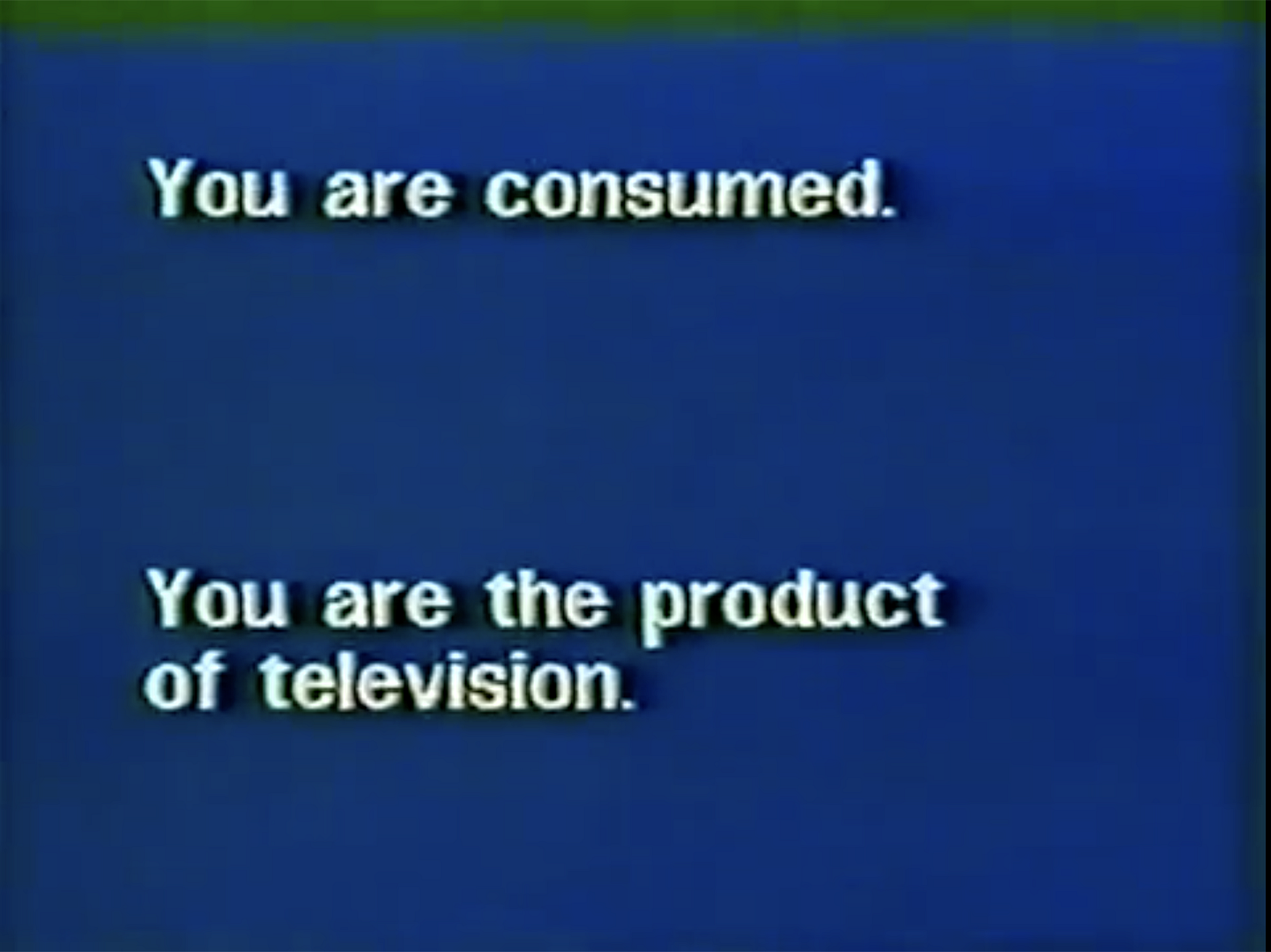

Richard Serra and Carlota Fay Schoolman, Television Delivers People, 1973, 7 min. Film still.
In the many transformations that have driven the evolution of moving-image media on the level of their material substrate—from the celluloid filmstrip, to electromagnetic transmission, to digital compression—the logic of consumption has been continuously reinscribed onto the boundaries of the camera-body-screen nexus. In each reiteration the human viewer is repositioned as food to be served up to the screen. This is the premise of Richard Serra and Carlota Fay Schoolman’s 1973 video Television Delivers People. The artists bought seven minutes of airtime on a public broadcaster to directly address viewers with a message intentionally communicated via the most reduced means possible: scrolling text on screen. This mode of address suggests that viewers, hypnotized by the seductive surface of the television screen, fail to perceive what is really going on; they willingly forfeit their free will to corporate overlords and state propaganda. The sobering text on screen is designed to make it clear that, contrary to its status as a commodity, television is not a product made for human consumption, but rather the opposite. As the artists wrote in the message: “Mass media means that a medium can deliver masses of people … It is the consumer who is consumed.” The video is ultimately about agency. To lose agency, they tell us—in the paranoid tone we recognize from the anonymous author who worried that humankind would be swallowed by the cinematograph—is to become food, to become less than human, to be reduced to matter for some greater sovereign being to consume.
A similar logic of consumption drives Grace Jones’s 2008 track “Corporate Cannibal” and its mesmerizing video. In it, Jones’s digital likeness is shown to be completely fluid, malleable into any conceivable shape. A body part erupts from an undulating graphic line, stretches beyond recognition, snaps back and replicates itself, all pulsing along to a hypnotic rhythm.15 As Jones stretches the boundaries of her body, she satirically inhabits the “corporate cannibal” who, sutured to the screen, turns its spectators into food:
Pleased to meet you
Pleased to have you on my plate
Your meat is sweet to me
Your destiny, your fate
You’re my life support
Your life is my sport …I’m a man, a man-eating machine …
Corporate cannibal, digital criminal
Corporate cannibal, eat you like an animal
Here again, the message is that to become food is to lose all agency, although in Jones’s rendition, the paranoia of consumption takes on a kind of pastiche. The restlessness of Jones’s malleability is particular to digital media and their rapid proliferation. Again, the moving image threatens to “swallow the whole of humankind in a violent deluge,” in the words of the anonymous author; but here the digitally rendered human form has become one with the digital liquidity of media and corporate finance, stretched nearly beyond recognition.
In David Cronenberg’s Videodrome (1983), the protagonist Max Renn, a TV station president played by James Wood, finds out about a plot to replace the real everyday world with a televisual world known as the Videodrome. In a famous scene, Max encounters the enigmatic TV presenter Brian O’Blivion who, speaking directly to Max, says: “Television is reality, and reality is less than television.” If the presenter’s statement is true, then for Max to enter “reality” he must enter the television, his own flesh subsumed by the machine’s material constitution. A moment later, the broadcast cuts to O’Blivion’s daughter Bianca, played by Debbie Harry. “Come to me,” she implores Max as the shot zooms in on her face. “Don’t make me wait.” As her open mouth fills the screen, Max delivers himself to be consumed by the screen. This scene brilliantly captures the dizzying slippages inherent to negotiating agency on the human-machine interface. The moving image is never content to remain bound to the machine that animates it because it is so good at mediating the human body (and many other organic processes and beings). The tremendous power of moving images lies in how they distill and amplify affect towards the dissolution of the boundary between the body and the machine.
In The Matrix (1999), the critical moment of Neo’s awakening from the simulation into “reality” comes when a 3D-rendered silver fluid coats his body, ultimately entering his mouth. The camera invades Neo’s mouth along with the fluid, which plunges down his throat on its way to reconstituting his body. Viewers are absorbed into the screen, whose digital graphics literalize the transformation of their bodies as digital subjects, traversing a digital threshold to be reborn in a new era.16 All these examples of the eat-the-camera effect show how every new medium fundamentally reconfigures the threshold of body and world according to the logic of its operations. The Big Swallow swallows viewers into a world remade by the logic of the cinematographic interval. Videodrome digests its protagonist, and thereby the viewer, into a centralized network that transmits via electromagnetic waves. The Matrix metabolizes the viewer into a world broken down into its molecular parts and reconstituted by the pixel and the digital compression codec.
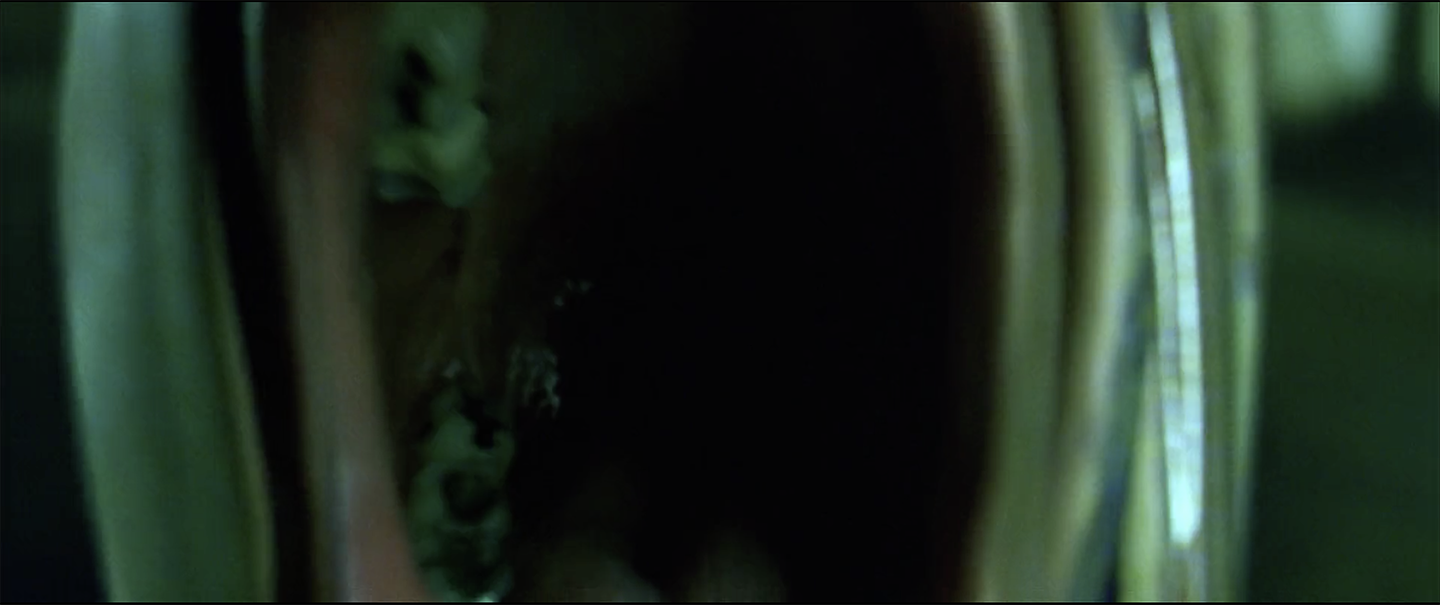

Lana and Lilly Wachowski, The Matrix, 1999. Film still.
The modern concept of metabolism was forged during the industrial expansion of Europe’s imperial reach, and was conceived as a model of total conversion wherein food is dissolved completely upon entering the hegemonic eater’s maw. When we view the concept of metabolism not as a stable definition of organic change, but as a historically specific model of agency grounded in consumption, then we encounter this agency, over and over again, as the extra-human agency driving cinema’s morphogenesis. We viewers are told again and again that the moving image wants to consume us, to rob us of our agency, to dispossess both our physical bodies and what makes us human. This message arrives in the form of an open mouth filling the screen. Bernard’s historically particular notion of a freedom derived from consumption took for granted that the human individual was positioned at the top of the food chain. In the cinematically reconstituted world, consumption reigns supreme but humans are no longer sovereign. Instead, the human is positioned as stuff, always identical, to be consumed by the extra-human screen, to become indistinguishable from the cinema’s own body.
3. Metabolizing Moving Images
In 2017, a group of scientists working at the intersection of molecular biology and neuroscience published an article in Nature detailing the results of an experiment that used the CRISPR-Cas system to encode a moving image into the DNA of living bacteria.17 The images they chose to encode were none other than Eadweard Muybridge’s iconic 1879 sequence of photographic stills capturing a horse in full gallop—images credited with establishing some of the technical conditions for cinematographic motion. The decision to use Muybridge’s stills as the first animation to be encoded in a cell’s genome was a nod towards the intertwined histories of moving image and biological motion. George Church, one of the researchers involved in the experiment, explains that its aim was to collect biological information over time: “A horse galloping is biological information over time, and is one of the first examples of recording any kind of motion, especially biological motion.”18
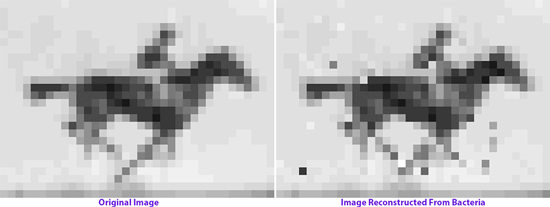

Seth Shipman worked in collaboration with George Church, using CRISPR to enable the chronological recording of digital information, showcasing the DNA’s potential as a storage device.
“DNA is an excellent medium for archiving data,” write the authors of the Nature article.19 Muybridge’s horse images are by no means the first data to be stored and retrieved from DNA. Over the past two decades, multiple projects have delivered data into living cells.20 The idea that DNA could be used as a storage device dates back to the very discovery of the double helix by Francis Crick and James Watson, when the physicist Richard E. Feynman imagined the vast data storage that would be opened up if information could be encoded into genetic sequences.21 But this possibility couldn’t be realized until computation became powerful enough to sequence and edit genes in a concrete and targeted way. For just over a decade now, the CRISPR-Cas system has made it possible to locate a specific sequence of DNA within a cell and replace it with something else. Essentially any data that can be expressed in binary code can be converted into the A, G, C, and T nucleobases that make up DNA’s double helix.
For the Muybridge animation, the five individual frames were broken down into their pixel values, each of which was then encoded into the nucleotides of DNA across approximately one hundred different genetic strands. These strands were fed to living bacteria, which incorporated the strands into their own genome. Once the strands become part of the living bacteria’s genome, they continue to be inscribed in the cell’s DNA every time it replicates. The researchers were also interested in using the bacteria’s own temporality to reproduce the animation’s chronology. Accordingly, they fed the bacteria the information contained within each still over a period of five days. Not only did the five individual images in the animation come out intact (with around 90 percent efficiency); they also came out in sequential order because the molecular recording system retained information about when the strands were fed to the cells.
The article in Nature is a step-by-step breakdown of how the data was delivered to the CRISPR-Cas system, written in technical terms that are difficult to grasp without specialist knowledge. Still, the story became quite popular and was reported in most major Western media outlets, each of which put a slightly different spin on the story. In one case, an author mused on how long it will be until we can store all of Game of Thrones in our skin.22 The researchers calculated that a single gram of DNA can store one billion terabytes, a number that has been extrapolated into an abstract, scalable figure representing an almost limitless storage horizon.23 Yet Seth Shipman, the lead researcher on the experiment, is clear that his aim in developing this process is not to create a giant database or to store TV shows in people’s skin. It is rather to create systems that will allow a cell to record data from its surroundings over time on its own. “We want to turn cells into historians,” Shipman told the online journal Alphr.24 Trained as a neuroscientist, Shipman’s concern is our limited ability to study the brain. The available methods for studying neurological activity inevitably disrupt the cognitive processes being observed, thus making any observation extremely partial. If a cell could be inserted into the brain as a “molecular recorder,” in Shipman’s words, it would be possible to collect data about neurological activity in the brain without interfering with the very processes one wishes to study.
Can we speak about this kind of data as “imagery”? The images in the reconstructed GIF of the horse, encoded in the DNA of living bacteria, are only images at the point of the translation of data to pixels to screens to human eyes. In this sense, the images themselves are not necessary to the experiment’s function. They are visual demonstrations, made to illustrate scientific and technological processes that may otherwise be too complex for the nonspecialist to comprehend. And yet in many ways they function as all other digital images do, atomized into bits of data and then reconstituted, via digital compression, for the eye. What makes such an experiment even thinkable is the dramatic transformation of moving images through digitization, driving a post-cinematic media environment that, in Thomas Elsaesser’s words, is “no longer grounded in the eye, in vision, or in visuality.”25
The experiment is meaningful because it illuminates a cross section of the ever-diminishing gap between how living things are observed and manipulated, and how images are produced and transmitted. In her illuminating work on the evolving relationship between images and scientific models of “life,” Deborah Levitt writes that life and images “can be properly seen only when viewed in relation with the other.” This coevolutionary relation is what she calls “the mediology of life and the life of media.”26 Reconfigured through computation, images become data at the same time as organisms do.
The new metabolism that has emerged in recent decades, which Landecker has dubbed “post-industrial metabolism,” reflects the current social and technological conditions in which it operates:
Both a conceptual domain and a set of experimental practices, this new metabolism is a regulatory zone, not a factory system; it is understood to be constituted by a dynamic web of cellular signals, built by and responding to environmental information—food molecules or food’s pollutants. Its disorders are regulatory crises.27
This operational reconstitution of organic change as data, both conceptually and experimentally, is what allows a living cell to become a morphogenetic storage device for a sequence of pixels that together make a moving image.
If cinematic conventions, since the very beginning, have been trying to swallow viewers—that is, to penetrate through the barrier of the screen on the one hand, and the body on the other—how does one interpret a new physical reality where sub-perceptual components of images (pixels) can now be physically incorporated into the sub-perceptual components of living organisms (nucleobases)? The issue is not whether we will start watching movies stored in our skin. At stake is how this emergent physical reality begins to trickle through the stories we tell about who we are as humans and our position in the world among other living things. These stories create forms, images, relations, and thought structures that operate on the physical world, changing both what it is and what it can be.
A robust and rapidly growing scientific framework demonstrates that organisms do not simply disappear into the organisms they are eaten by. Long after one organism has been digested by another, components of the eaten organism participate in the tasks of regulating vital functions in its host’s body. Against this new backdrop, the logic that sees the eater and the eaten as becoming contiguous through hierarchical consumption is shown to be historically particular, a cultural construct forged at the height of European colonial and industrial expansion, which obscured as much as it revealed about the science of digestion. With a newly reconfigured model of organisms as holobionts comes a radically new kind of image, an image that lives and reproduces as data that can be metabolized and incorporated into living organisms. This image can become an active part of a bacteria’s identity while retaining its own distinct identity as a pixel linked to other pixels. Even if these images will not determine the future of viewership, they tell us very clearly that it is no longer meaningful to draw hard lines between the organic and the technological, the dead and the living, the eater and the eaten. Instead, we shift to understanding self and world as constantly mutating relations of collaborative agencies.
Despite these new physical models of life-forms and images, cultural narratives steeped in the paranoia of consumption remain firmly embedded in discourses around the separations between humans, machines, and environment. Fears that the new extra-human systems we have produced such as DALL-E2 and GPT3 will dispossess human beings of the cultural forms—literature and art—that supposedly most distinguish us, not only from other life-forms but from machines, bear a striking resemblance to the paranoia triggered by the cinematograph a century ago. What is this paranoia if not the fear of losing an abstracted notion of agency? This fear takes for granted the myth that agency has always been autonomous. What changes when the myth of consumption-driven freedom is replaced by an acknowledgement that beings coproduce one another, in some ways that can be measured, and many more that cannot? What if we reconsider our fears of being swallowed by the machines that dispossess us of our agency, as a byproduct of the scientific concepts and cultural narratives that have historically denied the agency of the innumerable life-forms already inside us, all of which coproduce the broader agency that we call ours? What images and stories will emerge through the acknowledgement that agency is only ever borrowed from the multiplicities of planetary and cosmic agencies through which life emerges?
The Formation of the Scientific Mind: A Contribution to a Psychoanalysis of Objective Knowledge, trans. Mary McAllester Jones (1938; Clinamen Press, 2002), 172. Italics in original.
Bachelard, Formation, 175.
“The Metabolism of Philosophy, In Three Parts,” in Dialectic and Paradox: Configurations of the Third in Modernity, ed. Berhard Malkmus and Ian Cooper (Peter Lang, 2013), 198. Italics in original.
Landecker, “Metabolism, Reproduction, and the Aftermath of Categories,” in The Scholar and Feminist Online 11, no. 3 (Summer 2013) →.
Symbiotic Planet: A New Look at Evolution (Perseus Books, 1998).
“Metabolism, Autonomy, and Individuality,” in Biological Individuality: Integrating Scientific, Philosophical, and Historical Perspectives, ed. Scott Lidgard and Lynn Nyhart (University of Chicago Press, 2017), 232.
Fritz Schimmer, “On the Question of a National Film Archive” (1926), in The Promise of Cinema: German Film Theory 1907–1933, ed. Nicholas Baer, Anton Kaes, and Michael Cowan (University of California Press, 2016), 102.
Esfir Shub, “Selected Writings,” trans. Anastasia Kostina, Feminist Media Histories 2, no. 3 (Summer 2016): 11.
Adrian Ivakhiv, “The Art of Morphogenesis: Cinema in and beyond the Capitalocene,” in Post-Cinema: Theorizing 21st-Century Film, ed. Shane Denson and Julia Leyda (REFRAME Books, 2016).
L. U. Marks, The Skin of Film: Intercultural Cinema, Embodiment, and the Senses (Duke University Press, 2000.)
Terry Ramsaye, A Million and One Nights: A History of the Motion Picture Through 1925 (Simon and Schuster, 1926), xxxviii.
Anonymous, “New Terrain for Cinematographic Theaters,” in The Promise of Cinema, 22.
Michael Brooke, “The Big Swallow (1901),” BFI Screen Online →.
See also Mary Ann Doane, Bigger Than Life: The Close-Up and Scale in the Cinema (Duke University Press, 2021); and Thomas Elsaesser and Malte Hagener, Film Theory: An Introduction Through the Senses (Routledge, 2010).
See also Steven Shaviro, “Post-Cinematic Affect,” in Post-Cinema.
The Wachowskis shot The Matrix on film because video had not yet achieved cinema-quality images in 1999, but the postproduction treatment and the visual formalization of their ideas already envisioned cinema’s digital overhaul.
Seth Shipman et al., “CRISPR-Cas Encoding of a Digital Movie into the Genomes of a Population of Living Bacteria,” Nature, no. 547 (2017).
Quoted in “CRISPR-Cas: Molecular Recording,” YouTube video, July 12, 2017 →.
Shipman et al., “CRISPR-Cas Encoding,” 345.
Ed Yong, “Scientists Can Use CRISPR to Store Images and Movies in Bacteria,” The Atlantic, July 12, 2017 →.
“Plenty of Room at the Bottom,” lecture presented to the American Physical Society, Pasadena, California, December 1959.
Angela Chen, “A New Place to Share GIFs: The DNA of Living Bacteria,” The Verge, July 12, 2017 →.
Mussaad M. Al-Razouki, “The Future of Data Storage Is in You,” Medium, 2017 →.
Thomas McMullan, “Scientists Have Used CRISPR To Store a GIF Inside the DNA of A Living Cell,” Alphr, July 13, 2017 →.
Film History as Media Archaeology: Tracking Digital Cinema (Amsterdam University Press, 2016), 266. See also Jussi Parikka’s concept of “invisuality,” which charts the shift of operational images from “optics of vision” to “logistics of data”: Operational Images: From the Visual to the Invisual (University of Minnesota Press, forthcoming 2023). An excerpt from the book appears in this issue.
The Animatic Apparatus: Animation, Vitality, and the Futures of the Image (Zero Books, 2018), 2, 3.
Landecker, “Post-Industrial Metabolism: Fat Knowledge,” Public Culture 25, no. 3 (2013): 496.
The author would like to express deep gratitude to Sasha Litvintseva, Elvia Wilk, and Jussi Parikka for their close reading and incisive feedback at different stages of writing this text.
